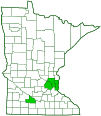cockspur hawthorn
(Crataegus crus-galli var. crus-galli)
Conservation • Wetland • Description • Habitat • Ecology • Use • Distribution • Taxonomy
Description |
||
Cockspur hawthorn is usually a very small tree but sometimes takes the form of a tree-like shrub. It can get up to 40′ tall and up to 12′ in diameter but in the northern states it is usually no more than 25′ in height and 9′ in diameter. It rises usually on a single stem from a woody, branching root system. It is moderate-growing horizontally but slow-growing vertically. The trunk is short, often crooked, and armed with sharp, branched, up to 4″ long thorns. The crown is low, widely spreading, broadly rounded or depressed, and densely branched. The branches are densely twiggy and have numerous thorns. The thorns are slender, unbranched, straight or slightly curved, and 2″ to 2¾″ long. The thorns on the lower half of the stem are turned downward, resembling the spur on a rooster, and giving the plant the common name “cockspur”. Bark on young branches is gray and slightly rough. Bark on older trunks is separated into flat, plate-like scales that become loose at both ends. First year twigs are light green and hairless with numerous small, white pores (lenticels). Second year twigs are smooth, reddish or brownish, and hairless, with numerous small, white lenticels. Buds are plainly visible, not submerged or partially hidden. They are covered with 6 bright red or dark red, thick, hairless, somewhat fleshy scales. They are gummy when pressed between the fingers. The terminal bud is round to egg-shaped. The leaf scar is flat or only slightly raised, and has 3 bundle scars. The pith is round or nearly round and solid, not spongy. The leaves are alternate and deciduous. They are on hairless, light green leaf stalks (petioles). The petioles are ⅛″ to ¾″ long. They are not winged and do not have red glands on the margins. There are two types of leaves. The leaf blades on flowering twigs are usually inversely egg-shaped or narrowly inversely egg-shaped, sometimes elliptic. They are leathery, ¾″ to 2¾″ long, ⅜″to 1⅜″wide, and unlobed or nearly unlobed. They are at least twice as long as wide. They are narrowly wedge-shaped at the base and rounded at the tip. There is a prominent midvein and several lateral veins. The lateral veins branch before reaching the margin. The upper surface is dark green, hairless, and shiny. The lateral veins and usually also the midvein are not at all impressed on the upper surface. The lower surface is pale green and hairless. A network of veins between the lateral veins is visible on the lower surface. The margins are finely toothed, at least above the middle, with sharp, forward pointing teeth. Leaf blades on non-flowering twigs are larger, 2″ to 3½″ long and 1¼″ to 3″ wide, and are sometimes more obviously lobed. The inflorescence is a branched, flat-topped cluster (corymb) of several flowers at the ends of twigs and branches. The corymbs are 2″ to 3″ in diameter. The stalks of the corymb and stalks of individual flowers are light green and hairless. Each individual flower is up to ½″ in diameter. There are 5 sepals, 5 petals, about 10 stamens, and 2 or 3 styles. The sepals are green and are fused at the base into a short tube and separated at the tip into 5 untoothed, narrowly lance-shaped to linear lobes. The petals are white and widely spreading. The stamens have pink or pale yellow anthers. The flowers are foul-smelling. The fruit is a seed capsule with a fleshy, outer covering (pome). The pome is globe-shaped and ¼″ to ⅝″ in diameter. It is green at first, becoming red when it reaches maturity in late mid-September to early October. |
||
Height |
||
Up to 25′ |
||
Flower Color |
||
White |
||
Similar Species |
||
| Dotted hawthorn (Crataegus punctata) leaves are hairy, at least on the lower surface. The upper leaf surface is dull, not shiny. The midvein and lateral veins are impressed on the upper leaf surface. | ||
Habitat |
||
Moderate moisture to dry. River banks, streambanks, shores, woodland borders, fields, pastures, roadsides. Full to partial sun. |
||
Ecology |
||
Flowering |
||
Late May |
||
Pests and Diseases |
||
Cedar-hawthorn Rust (Gymnosporangium globosum) Entomosporium Leaf Spot (Diplocarpon mespili) fire blight (Erwinia amylovora) hawthorn leafminer (Profenusa canadensis) |
||
Use |
||
A spineless form of cockspur hawthorn is a popular cultivar. |
||
Distribution |
||||
|
Sources |
|||
| 3/26/2023 | ||||
Nativity |
||||
Native to the eastern half of North America, including Wisconsin and Iowa. Historically native to Minnesota but no current populations known. |
||||
Occurrence |
||||
Rare or absent, possibly extirpated in Minnesota |
||||
Taxonomy |
|||
| Kingdom | Plantae (Plants) | ||
| Subkingdom | Pteridobiotina | ||
| Phylum | Tracheophyta (Vascular Plants) | ||
| Class | Magnoliopsida (Dicots) | ||
Order |
Rosales (Roses, Elms, Figs, and Allies) | ||
Family |
Rosaceae (Rose) | ||
| Subfamily | Amygdaloideae | ||
| Tribe | Maleae | ||
| Subtribe | Malinae | ||
Genus |
Crataegus (hawthorns) | ||
| Section | Coccineae | ||
| Series | Crus-galli | ||
| Species | Crataegus crus-galli (cockspur hawthorn) | ||
There are three varieties of cockspur hawthorn. Only the nominate variety, var. crus-galli, occurs – or once occurred – in Minnesota. |
|||
Subordinate Taxa |
|||
|
|||
Synonyms |
|||
Common Names |
|||
bush hawthorn cockspur hawthorn cockspur thorn |
|||
Glossary
Corymb
A flat-topped or convex inflorescence in which the stalked flowers grow upward from various points on the main stem to approximately the same horizontal plane. The outer flowers open first.
Lenticel
A corky, round or stripe-like, usually raised, pore-like opening in bark that allows for gas exchange.
Linear
Long, straight, and narrow, with more or less parallel sides, like a blade of grass.
Petiole
On plants: The stalk of a leaf blade or a compound leaf that attaches it to the stem. On ants and wasps: The constricted first one or two segments of the rear part of the body.
Pith
The spongy cells in the center of the stem.
Pome
A fruit with a central seed bearing core enclosed in thick flesh, e.g., an apple or pear.
Stipule
A small, leaf-like, scale-like, glandular, or rarely spiny appendage found at the base of a leaf stalk, usually occurring in pairs and usually dropping soon.
Visitor Photos |
|||||
Share your photo of this plant. |
|||||
| This button not working for you? Simply email us at info@MinnesotaSeasons.com. Attach one or more photos and, if you like, a caption. |
|||||
Kirk Nelson |
|||||
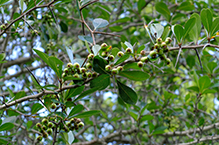 |
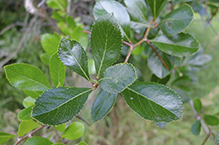 |
||||
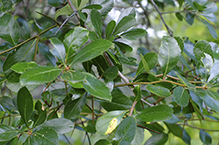 |
|||||
MinnesotaSeasons.com Photos |
|||||
|
|||||

Slideshows |
||
| Cockspur Hawthorn Tree Andree Reno Sanborn |
||
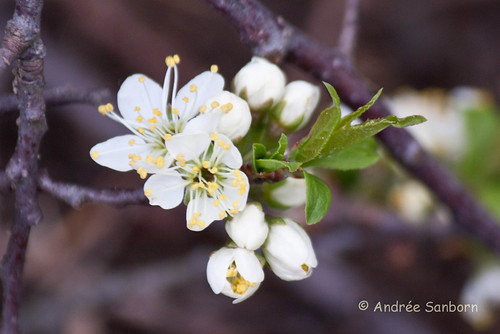
|
||
About
Crataegus crus-galli |
||
| Crataegus crus galli Angie Holmberg |
||
About
Published on Jul 30, 2014
|
||

Visitor Videos |
|||
Share your video of this plant. |
|||
| This button not working for you? Simply email us at info@MinnesotaSeasons.com. Attach a video, a YouTube link, or a cloud storage link. |
|||
Other Videos |
|||
| Cockspur Hawthorn (Crataegus crus-galli) TheCampusTrees |
|||
About
Published on Apr 12, 2012
|
|||

Visitor Sightings |
|||||
Report a sighting of this plant. |
|||||
| This button not working for you? Simply email us at info@MinnesotaSeasons.com. Be sure to include a location. |
|||||
| Kirk Nelson 8/24/2014 |
Location: Baker Park Reserve I saw this next to the Lake Independence Regional Trail in Baker Park Reserve. It appears to be a Cockspur Hawthorn (Crataegus crus-galli) |
 |
|||
MinnesotaSeasons.com Sightings |
|||||
|
|||||

|
Created: Last Updated: © MinnesotaSeasons.com. All rights reserved. |
